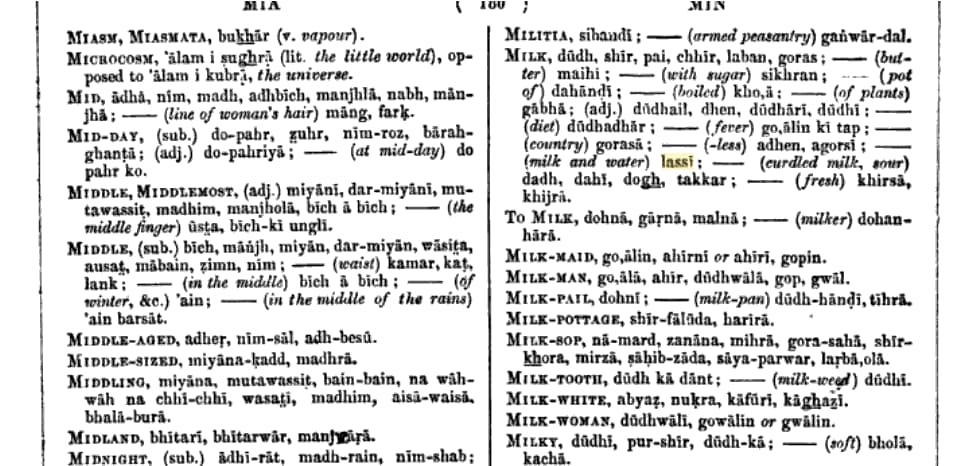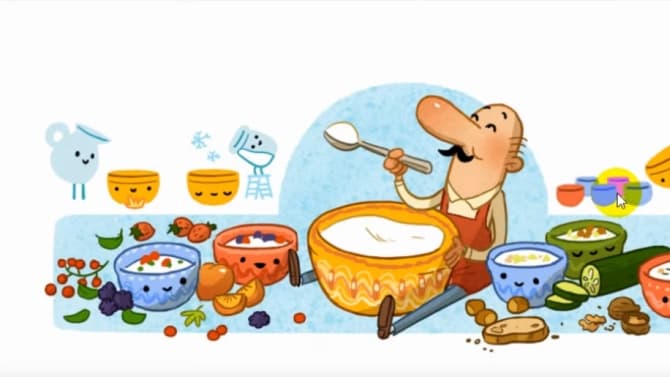Table of Contents
Lassie, what a great story; even movies were made about it. It was… wait a minute! This is not a movie blog; it is about drinks and recipes. I see what misled me now: a simple typo: Lassi, not Lassie.
Ok, let’s start again.
Lassi is a refreshing and nutritional drink that is one of the traditional beverages in India. It has a creamy texture and sweet-sour-savory taste and is made with yogurt, water, and often sweetener or salt.
Ancient Smoothie
Lassi is probably one of the first smoothies ever created. It is a truly ancient drink that originated around 1000 BC in Punjab and Multan, India.


The exact time is unknown, but considering that the yogurt was known to people in Mesopotamia since around 5000 BC, we can only imagine that with the establishment of the trade route between two of these regions, most of the timing of the smoothie creation was about right, 1000 BC.
A simple mixture of yogurt and honey was referred to “as the food of the gods” 1, was it the predecessor of the Lassi? We can only guess, but it surely tastes good even today.
According to Arun Chopra, an executive chef of the Taj Mahal Hotel2.
“In the old days, when there were no refrigerators, the Punjabi farmers used to drink milk cooled in a clay pot and mixed with curd and sugar and stirred by a wooden stick,”
Yogurt and sugar sound great; however, many other flavours can be added, creating delicious twists to the traditional yogurt drink.
So the question is, where does the idea of adding additional ingredients like fruits and spices come from? Well, with the abundance of fruits everywhere, that was a no-brainer, and what about the spices?
I believe the reason was Ayurveda. Ayurvedic medicine is a healthy lifestyle system that people in India have used for over 5,000 years. It emphasizes lifestyle behaviour and herbal remedies to improve one’s well-being. Introducing spices, like cumin and cardamom, and herbs were very familiar to the locals, so naturally, they added these additional flavours into the Lassi.
Some of these spices are known for/or believed to have healing properties and calming effects on the digestive and the immune system.
Types of Lassi Drinks
One might say that they are there are two main types:
- Lassi with yogurt
- Lassi is made with buttermilk – known as chaos or mattha – the spicier version of chaos.
They might be prepared similarly or often be confused, but their base is different.
Buttermilk is the leftover liquid when butter is churned out of cream. It is less acidic, slightly sour, and more watery than Lassi.
One way to make buttermilk* without churning the butter is to combine 1 cup of whole milk with 1/2 ounce of fresh lemon juice or vinegar.
Buttermilk is not only a very popular cooling drink but also helps digestion.

I have to say, though, that buttermilk*, traditionally drunk in India, is not the same as the one known in North America, which is cultured buttermilk*. It has a different taste and is pasteurized and homogenized milk.
On the other hand, Lassi is made with yogurt (made by fermenting the milk and adding a culture of bacteria (Streptococcus lactis or Lactobacillus bulgaricus) to room temperature milk). It is kept for 6 to 8 hours to make thick yogurt. The yogurt is then churned with a blender to make Lassi; whether we add water to it will depend on the creaminess of the yogurt.

Using yogurt made in Bulgaria and Greece will add the necessary creaminess, thickness, and health benefits to your mixture. The bacteria causing the milk fermentation (Lactobacillus bulgaricus) was discovered in 1905 by a Bulgarian scientist, dr. Stamen Grigorov (Стамен Григоров). His house in Bulgaria is currently a yogurt museum, and Google commemorated him in 2020 on its main page with a traditional doodle.
I have more information about this type of yogurt under the Health Benefits part of the post.
Lassi Tastes – sweet, salted, savory
Salted Lassi
It is made with a mixture of dahi (yogurt), water, and salt, which is traditionally popular in the southern parts. Very similar to what is known as Ayran (Айран) in Turkey and Bulgaria.
It is usually spiced and flavoured with black Himalayan salt, which is praised in Ayurveda for its medical qualities, roasted cumin powder, and mint leaves.
Sweet Lassi
It is mainly popular in the northern parts of India. It’s a creamy, iced blend of yogurt, water, fruit, sugar, and spices. Depending on the amount of water added, the texture is similar to a milkshake. It is a very refreshing drink taken any time during the day.
Bhang Lassi – a special category

Bhang lassi is a cannabis-infused drink that contains bhang, a liquid derivative of cannabis.
Bhang is a by-product of the Hemp plant, and even though the Hemp plants and marijuana plants are both the same species, their level of THC is different.
Legally, hemp is defined as a cannabis plant that contains 0.3 percent or less THC, while marijuana is a cannabis plant that has more than 0.3 percent THC3.
Whether or not you can drink or buy the Bhang type of Lassi outside of India will depend on the local laws.
Masala Lassi
Masala^ spices mixed with yogurt. Masala describes a spice blend used in a recipe.
Health benefits^
If we look at the health benefits of Lassi, salted or sweet, they are mainly dependent on the yogurt being used. Here are the benefits of good quality yogurt.

Yogurt contains some of nearly every nutrient that your body needs:4
• It’s High in Protein – it gives strength to the muscles
• Benefits Digestive Health – depending on if it contains live, active cultures, probiotics – it helps to develop healthy bacteria in the stomach
• It May Strengthen Your Immune System
• It May Protect Against Osteoporosis – it has calcium, it helps build strong bones and teeth
• It May Benefit Heart Health
• It May Promote Weight Management – probiotics
• Buttermilk may reduce heartburn by coating the stomach lining and preventing the acids from moving towards the esophagus. This is also one of its benefits.
The table below shows some differences between yogurt and buttermilk* and how they might affect the nutritional value of Lassi or chaas.
All the Daily Values are presented for males aged 31-50 for 2000-calorie diets.
| Yogourt – one container 170g | Buttermilk per 100g |
| Fat 0.39 g | 0.88 g |
| Calcium 110 | 116mg |
| Energy 59kcal | 40kcal |
| Carbs 3.6 g | 4.79 g |
| Cholesterol 5mg | 4 mg |
| https://foodstruct.com/ – All data is for information purposes only. | The data will also vary based on the different dairy producers. |
The big unknown here is the sugar; being part of most recipes will negate some of the benefits and increase the calorie intake. If you are looking for sugar substitutes, honey, maple syrup, and fresh or dried fruits might be suitable replacements in a recipe.
The same is true for the salted Lassi; too much salt might increase blood pressure and create kidney problems.
By adding ingredients to the recipes, the nutritional values will vary, as there is no clear winner here; besides the Fat content, I can say we have to treat ourselves occasionally.
If we look at the positives and negatives of the essential ingredients for Lassi and chaas, one can say, “Moderation is the key.” Enjoy it, and don’t get addicted to it.
Bulgarian yogurt vs Greek Yogurt
One is not necessarily better, but some differences exist, like protein content, fat, and probiotic benefits.
Jigsaw Health TV’s short video has a good explanation of both kinds of yogurt.
Lassi variations around the world
There are many similar yogurt-based drinks in different parts of the world.
In the Balkans, yogurt is a big part of the local cuisine in Bulgaria, Greece, and Turkey. Ayran (Айрян in Bulgaria) is a very popular drink. It is made from yogurt, water, salt, and sometimes black pepper and mint. It is very refreshing to drink, especially in the summer months. In Bulgaria, the ayran producers also use buttermilk to make the beverage.
This drink is popular in the Balkans and Southeast Europe, Central Asia, and the Middle East.
Tarator is a delicious cold soup/drink found in Southeast European and Middle Eastern cuisines. It is made of salted strained yogurt or diluted yogurt mixed with cucumbers, garlic, salt, olive oil, sometimes vinegar or lemon juice, and herbs such as dill, mint, parsley, and thyme.
Kefir originated in Armenia; it is a fermented milk drink similar to ayran. Numerous books and articles have been written about the kefir health benefits.
Tan: In Armenia, it is prepared by blending yogurt, water, and salt. It is consumed chilled.
Leben refers to a food or beverage of fermented milk – buttermilk and yogurt, in North Africa and the Middle East.
Tibicos, or water kefir, is a traditional fermented drink with water. It is commercially sold as a carbonated beverage.
Doogh: In Afghanistan and Iran, Lassi, made of water, yogurt, and spices, is called doogh.
Filmjölk, known as fil, is a traditional fermented milk product from Sweden and a standard dairy product in Nordic countries. It is suitable for those who are lactose intolerant. It has a sour taste5.
The popularity of yogurt-based drinks and their refreshing and nutritional benefits is such that I’m sure there are many more similar locally created drinks.
In North America6, the lassi drink became popular around 40-50 years ago and is one of the staples in Indian restaurants. Major dairy brands realized the diversity of society, the demand for new products, and the desire to explore new flavours led to the introduction of many Lassi types of beverages.
These companies realized people are more likely to settle for “grab and go” products in a fast-paced society. That led to the introduction of diversified product lines, such as Frozen Lassi, Aromatic blend Nut-flavored blends, High fibre, salty, savoury, and fruity drinks, desserts, and even gin-lassi infused Crazy gin.
While this is a convenient choice to enjoy a refreshing drink, I’d make my own using fresh ingredients and flavour combinations without additives.
Lassi Recipes
The texture of the drinks will depend on the creaminess of the yogurt. If the texture is watery, reduce the water or add cream to achieve the desired consistency.
The ratio of water to yogurt should not be more than 50%; in many cases, it is much less.
Sweet Lassi – Base recipe
The recipe is a base for sweet lassi flavor variations. It consists of only three ingredients.
2 cups of yogurt
1/2 cup to 1 cup of water -depends on the yogurt fat content and creaminess
2-3 level spoons of sugar or honey
Blend with a little bit of ice and pour over into a chilled glass.
Any flavors can be added to this recipe and blended.
Mango Lassi
1 cup chopped very ripe mango or frozen chopped mango,
1 cup plain yogurt
1/2 cup water – optional for a thinner consistency
4 teaspoons honey or sugar, more or less to taste – if using sweet mangoes, skip the sweetener
few ice cubes
Peel mangoes and cut the pulp from the stones. Pulse pulp in a food processor
Add yogurt and sweetener. Blend and serve. Garnish with mango slices and mint.
Note: Drinks made with fruits best enjoyed right away might turn sour if left in a fridge for a long time.
Strawberry Peppercorn Lassi
1 ½ cup cold yogurt
½ cup of water
2 to 3 strawberries, sliced
5 mint leaves
1 oz honey
6 to 7 grinds of fresh black pepper – crushed
Blend everything. Add ice if the yogurt is not cold. Pour into a chilled glass and garnish with mint.
Mango Cardamom Lassi
1 cup chopped very ripe mango or frozen chopped mango,
1 cup plain yogurt
1/2 teaspoon cardamom
1/2 cup milk – optional for a thinner consistency
4 teaspoons honey or sugar, more or less to taste
Few ice cubes
Peel mangoes and cut the pulp from the stones. Pulse pulp in a food processor
Add yogurt, cardamom, and sweetener. Blend and serve. Garnish with mango cubes and mint.
Chocolate Chili Lassi
1 ½ cup cold yogurt
½ cup of water
1 oz chocolate syrup
1 teaspoon crushed chilli flakes
pinch of crushed pink peppercorn
½ teaspoon cinnamon
Blend everything except the pink peppercorn, pour into a chilled glass, and sprinkle on a top pink peppercorn.
Flavour ideas: Orange, papaya, lychee, caramel syrup – made the same way – mixed with yogurt, water, and sweetener.
Salted Lassi–Base Recipe
2 cups cold yogurt
3/4 cup water
1 teaspoon black salt or regular salt
Few mint leaves – optional
Blend everything and pour into a glass, if yogurt is not cold add some ice.
Garnish with mint.
Note:
The recipe can be used as a base to add additional flavors such as ginger, coriander, cumin, saffron, mint, chopped nuts – almonds, pistachio, cashews, etc. Nuts can be stirred into lassi after blending, or blend together – it is a personal preference.
- If using whole spices, bake them for 3-5 min – to release more flavour and/or grind them to a fine powder before mixing them with yogurt. If there is no time for baking, grind the spices directly and blend.
- If adding powdered spices, roast them in a shallow pan for 30 seconds.
- Cumin: Roast cumin seeds, no oil, in a small skillet for about 30 seconds. Grind in a spice/coffee grinder and add to the mix before blending.
- Both methods are similar to chai masala preparation. For example, with whole spices, if there is no time for roasting, grind to powder and blend directly with yogurt.
- We make masala lassi using spices.
Masala Lassi
1 1/2 cup Yogurt
1/2 cup Water
4 green cardamom- crushed seeds only, husks removed
¼ teaspoon black peppercorn – crushed
2-3 saffron threads
1 tablespoon shelled pistachios – chopped
6 Mint leaves
1/2 tbsp Ginger roughly chopped
Pinch of salt – optional
Instructions:
Add yogurt, water, cardamom, peppercorn, mint, ginger, to a blender. Blend very well. Refrigerate for around a couple of hours.
Garnish with saffron threads and some chopped pistachios.
Notes: Adjust or substitute spices according to your taste. Whole spices need to be ground to powder consistency before blending.
All recipes can be modified by adding liquid vanilla ice cream and a scoop of ice, then blending, resulting in a frozen smoothie. It’s a drink pretty much everyone is familiar with.
Some other traditional Indian drinks are similar to Lassi but made with milk. They are called Thandai; one similarity between these two drinks is the use of a masala blend in their respective recipes.
Lassi Smoothie Recipe
Lassi Smoothie

Ingredients
- 4 cups yogurt
- 2 cups water
- 3 Tbsp yuzu marmalade*
- 1/2 cup strawberries and sliced banana
- 1 tsp vanilla extract
- 2 scoops of ice, if making a frozen thicker consistency smoothie - increase the ice to 1 serving glass of ice per person.
Instructions
Blend well for about 30-40 seconds. Pour into a tall glass.
Garnish with chopped cashew and strawberry.
Notes
Different garnish - grated nutmeg with a slice of strawberry.
Put less ice for a thinner consistency.
* If yuzu juice is available - preferable, use 2 oz with three spoons of honey.
Nutrition Information:
Yield:
4Serving Size:
1Amount Per Serving: Calories: 256Total Fat: 4gSaturated Fat: 3gTrans Fat: 0gUnsaturated Fat: 1gCholesterol: 15mgSodium: 187mgCarbohydrates: 43gFiber: 2gSugar: 36gProtein: 14g
This data was provided and calculated by Nutritionix.
Footnotes
- Batman, Najmieh (2007). A Taste of Persia: An Introduction to Persian Cooking
- https://www.nytimes.com/1989/08/09/garden/an-indian-drink-to-cool-summer-s-fire.html
- https://www.healthline.com/health/hemp-vs-marijuana#legality
- https://www.healthline.com/nutrition/7-benefits-of-yogurt#TOC_TITLE_HDR_5
- https://en.wikipedia.org/wiki/Filmj%C3%B6lk#cite_note-kulturmjoelk-grundfakta-3
- https://www.smithsonianmag.com/arts-culture/whats-a-lassi-92519178/




Hello, Neat post. There is a problem together with your site in internet explorer, could check this? IE still is the market chief and a huge part of people will leave out your excellent writing because of this problem.
I will look at that issue and see if anything can be done.
Internet Explorer is no longer supported and has been officially retired.